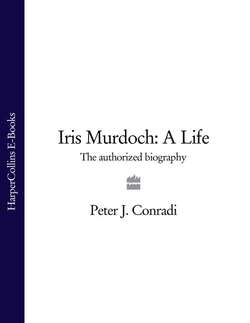Читать книгу Iris Murdoch: A Life: The Authorized Biography - Peter Conradi J. - Страница 33
6
ОглавлениеLeila Eveleigh recalled Iris as good all round – a good hockey player, interested in and gifted at art (painting), not particularly musical, though she ‘had a go’, but excelling at classics and English. Enthusiastic and alive in all her many activities, she was quiet and inward also. It would not be surprising if Iris’s omnicompetence aroused dislike or envy; none has stepped forward to say it did.52
Latin was taught first by rosy, large, countrified Miss Parkin. Then came Marjorie Bird: tall, thin, no make-up, very plainly dressed and a devout Quaker. Known as ‘The Bird’, she taught Iris Latin and Greek from 1934 to 1937. ‘What a help The Bird was,’ Iris later remembered. The only pupil mentioned by name in Miss Bird’s diaries for the thirties is Iris.*In Iris’s last year Miss Jeffery replaced her, a good scholar who should have been a don. She loved esoteric jokes, gave a brilliant lecture to the whole school on medieval Latin poetry, held Roman supper-parties for the out-of-school Classics Club. Teaching a ‘pearl’ like Iris must have cheered her up. Together they read some of Xenophon’s Anabasis, source of the tide for Iris’s Booker Prize-winning The Sea, The Sea, the Greeks’ cry during a war in Persia when they finally sight salt-water; also ‘those evergreen charmers’ Odyssey Books VI and VII. Miss Jeffery remembered Iris as ‘one of the kindest people [she] had ever met’.53 Iris’s excellent teacher of English, Miss Horsfall – known as ‘The Horse’ – tall, very thin and a little ungainly, wore pince-nez at the end of her nose, her hair in a bun, and was a devout Anglo-Catholic. She often read Iris’s exemplary essays out to the class. An atmosphere of emotionality surrounded her.
Successive issues of the Badminton School Magazine point to Iris’s impact on the school. In the autumn of 1933 she wrote up the new Architecture Club’s expedition to Bradford-on-Avon, describing the Tithe Barn and the ‘oldest existing’ Saxon Church of Saint Aldhelm, which the girls sketched. The following term she contributes to ‘Contrasting Views of Highbrows and Lowbrows’, a subject then exercising Virginia Woolf.54 Iris’s lowbrows follow Arsenal and go to the music-hall. Her highbrows read Dickens and Shakespeare and follow ‘the situation in Germany’ – suggesting how politically aware Badmintonians were. How many other English fourteen-year-olds were then preoccupied by Hitler, who had risen to power only a year before? Iris proposed tolerant understanding through a mutual expansion of pleasure-sources. The lowbrows should read Walter Scott and try Horowitz on the wireless; the highbrows should listen to dance-tunes. She was later to call the songs of the thirties ‘the best pop-tunes of the century’,55 and to regret that Badminton had so much Greek dancing, classical music, quickstep and Viennese waltz, and not enough jazz:56 ‘The most interesting kind of man is the one who knows something about everything.’ This looks forward to the kind of novel she would later hope to write, with, as she expressed it later, ‘something for everyone';57 ‘like Shakespeare’, John Bayley observed.
In the magazine in 1934 Iris celebrated the value of ‘Unimportant Persons’, amongst whom she includes herself. In 1935, as well as taking her School Certificate, she wrote ‘How I Would Govern the Country’, defending constitutional monarchy, criticising imperialism and totalitarianism alike; and after her trip to Geneva attended the League of Nations Junior Branch, published a piece on ‘Leonardo da Vinci as a Man of Science’, telling of his drainage schemes, canal-making machines, devices for measuring distance and wind-force, and for flying; acted as First Citizen in Laurence Housman’s The Peace Makers, played right half at hockey, won fifteen votes as Socialist candidate in a mock election for the Debating Society (Orpen for the National Conservatives won with twenty-two votes: the girls were less left-wing than their teachers*), and published a competent translation of Horace’s ode ‘Quis multa gracilis te puer in rosa’.† 1936 sees Iris vice-captain of her house, involved in League activities, the Debating Society, the 2nd XI hockey team, and writing a poem entitled ‘The Diver’ which recalls the 1930s fashion for the aviator as culture-hero but, in true Murdoch fashion, substitutes water for air and celebrates swimming instead. She writes up the activities of the Literary and Architecture Clubs (Lady Precious Stream,≠ Francis Bacon, Chesterton, an exhibition of Everyday Things in Bristol); acts in a parody of Euripides’ Alcestis ('Al’s Sisters') where, arrayed as a butler bearing cocktails, she is noted as ‘among the stars of the cast’, and also plays Hank Eisenbaum in ‘Hollywood Rehearses Shakespeare’. Her dramatic activities at Froebel and Badminton, and later at Oxford, are interesting. Although the adult and puritan Iris disliked theatre, young Iris enjoyed acting and was famous at Oxford for her talent.
